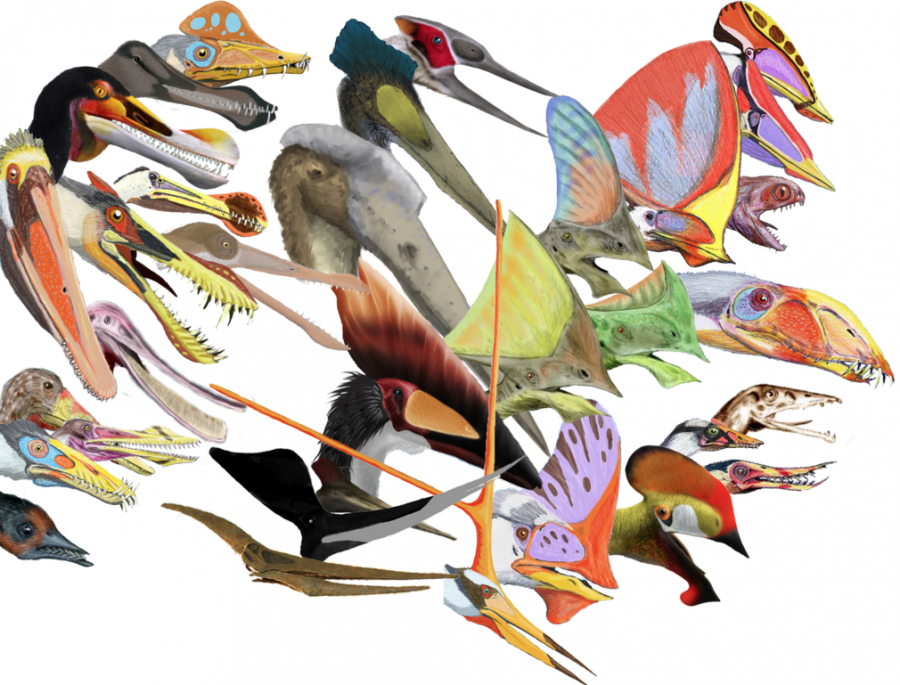Real Life Dragons
Rawr!
Pterosaurs are, in addition to the marine reptiles of the age of dinosaurs, one of the major groups of highly successful reptiles from the mesozoic that are commonly mistaken for dinosaurs. Although they were not true dinosaurs, these species were just as revolutionary in evolutionary history, being the first vertebrates known to develop true flight. Their system of physiological adaptations to flight is as sophisticated and adaptable as that of modern birds, allowing for both small and maneuverable and massive gliding forms. Pterosaur wings possessed a very unique shape: wing membrane extends from the tip of extremely long pinky fingers to the legs or ankles, filling in all the space in between with a highly complex sheet of crisscrossing fibers, muscles, and blood vessels wrapped up in a coating of tough skin. The remaining fingers of the pterosaurs hand are visible halfway up the “arm”, and enable the pterosaur to walk quadrupedally on its knuckles with its wing finger folded up close to its body. This system did not enable the fast running speeds of some modern birds but provided a wing structure that was more stable than bird’s feathers in flight and a strong, four legged lift off position. Some paleontologists believe that pterosaurs did not have to take any running start at all to become airborne, but in either case the strength of these features allowed pterosaurs to grow to the size of small airplanes, far larger than birds are capable of growing.
In addition to the wing, pterosaurs developed numerous other features to support their active, flying lifestyle. Like birds, pterosaurs developed bones that were at least partially hollow, with a matrix of bone columns within to provide support. Also like birds and other dinosaurs, the pterosaurs had a more advanced respiratory system than most other vertebrates, with lungs and other air sacks that allowed oxygen to be harvested more efficiently, better breath holding abilities, and even the ability to inhale multiple times before exhaling. This is an essential trait for high altitude flying and also helped provide an edge over other species at ground level. In addition to these birdlike traits pterosaurs developed a hair or down-like coating called pycnofiber, which was unique from both the feathers of dinosaurs and the fur and hair of mammals. This coating provided both insulation and a display feature to pterosaurs, but was absent from the wing membrane. This indicates that the pycnofiber had no aerodynamic function, but was instead a product of the pterosaurs’ warm blooded metabolism, which necessitates insulation. Scans of pterosaur brains have revealed that they have a massive center for managing touch and balance input relative to the rest of their brains called the flocculus. This is a vital component of a flying vertebrates, but pterosaur’s seem to outstrip birds by a noticeable margin in most cases. However, the average brain to body ratio in pterosaurs is smaller than birds, indicating that whatever their manual flight control capabilities they were less intelligent than birds.
Like dinosaurs and marine reptiles, pterosaurs first evolved during the Triassic, about 252 to 201 million years ago, and the first fossils appear in the more recent part of this era, the Late Triassic. Like dinosaurs and marine reptiles, they evolved as part of the ecological regeneration after the Permo-Triassic mass extinction. Unlike these other new groups, pterosaurs were inventing a wholly new ecological niche, whereas the others filled niches left vacant after the extinction. The early evolutionary history of pterosaurs is actually poorly known, because no transitional forms have been discovered. The oldest fossils are of small pterosaurs that had clearly already developed powered flight, such as the crow sized Petinosaurus. These species provide few clues as to the ultimate ancestor of pterosaurs, as they are already so unique due to their adaptations for flight. However, most paleontologists agree that pterosaurs are certainly archosaurs, and probably within the ornithodira group, which makes them very closely related to dinosaurs. However, they are clearly not dinosaurs due to their lacking many skeletal and biomechanical features of dinosaurs (take a look at my “How to Identify a Dinosaur” article for more information). These early pterosaurs never exceeded raven sized, and were largely insectivorous or scavenging. They were characterized by large heads and short necks relative to their body size, as well as a long tail ending in a rudder-like structure.
Pterosaurs following the early design would diversify and rule the skies through much of the Jurassic. These long tailed species spread around the world and adapted to many niches, from the seagull equivalent Rhamphorhynchus to the lizard and mammal eating Dimorphodon, but were all carnivorous. Rhamphorhynchus and its close kin were the largest, growing wingspans of around six feet wingtip to wingtip, similar to most modern eagles. However, neither they nor any of the other early pterosaurs developed bodies very different from their ancestors, and instead evolved unique heads, beaks, and teeth with which to handle their unique prey. In the Late Jurassic this changed, as a group of similar small pterosaurs lost their tails and began experimenting with unique wing shapes. This includes the first pterosaur ever discovered, the petite Pterodactylus, a cardinal sized beachcomber with a needle thin beak, and Anurognathus, an equally small pterosaur with a short, round snout and huge eyes for hunting insects by night. At the end of the Jurassic the tailed pterosaurs died off gradually for reasons that are currently unknown, leaving the tailless species to diversify in the Cretaceous.
As early birds evolved in the Cretaceous, the pterosaurs of this new group, Pterodactyloidea, evolved alongside them and claimed niches that called for massive body size. Only one group of primitive pterodactyloids had wingspans smaller than 7 feet from wingtip to wingtip, and within this mostly large body size they diversified in numerous fascinating forms. Many of these groups are poorly documented so far, and relationships between them are difficult to draw. However, the groups are obvious. The first of the two primary groups was the Pteranodontia, which was represented primarily by coastal, fish eating species. In North America, two forms of massive, largely fish eating pterosaurs developed: the Nyctosaurids, which had crest extending up to half their wingspan straight up into the air, and the iconic Pteranodons, with their crescent shaped crests. Both these groups spread across the northern hemisphere. In Eurasia, Istiodactylidae evolved to fill similar coastal and also land predatory roles. These species had broad bill-like mouths, which may have had throat pouches similar to the pelican’s. The Anhanguerids and Ornithocheirids were very closely related species with wingspans up to 30 feet from wingtip to wingtip, that typically had rounded crests on their upper and lower jaws and may have led globe travelling lives similar to albatrosses.
The second and somewhat more bizarre group was the Azhdarchoidea, which was predominantly populated with inland species. One of its most iconic groups was the Tapejaridae, which contained species with the largest head crests of any pterosaur. Some tapejarids had semicircular crests the size of garbage can lids or bigger, which coupled with their short beaks to give them the appearance of having a completely disk shaped head. The size of crests appears to have been gender based, indicating that it was primarily a courtship feature. Dsungaripterids also had large crests, but are better characterized by their upturned beaks and oversized and dangerous looking set of teeth. The use of these features has yet to be fully understood, but theories include uses in territorial battles, as hunting weapon, and as “tweezers” for prying prey out of narrow burrows. By far the largest Pterosaurs of all were this group’s Azhdarchids, which evolved over the course of the Cretaceous to become the largest flying animals ever by the late Cretaceous. These species also hold the distinction of having some of the largest heads of any animal, and the longest necks of any non-sauropod dinosaur ever. These huge creatures were thought to have been globe wandering opportunists, scavenging and preying on young or small dinosaurs as they pleased. Some of the largest include the famous Quetzalcoatlus, which was named after the Aztec sun god and had a typical wingspan of 39 feet, and the even larger and recently discovered Hatzegopteryx. Among the more primitive groups than Azhdarchoidea and Pteranodontia some groups developed unique and even occasionally large body shapes. The most notable of these was the Ctenochasmatoidea, which developed unique filter feeding pterosaurs with upwards curving jaws and layers of pycnofibers on the lower jaw that acted like baleen.
It was long believed that pterosaurs were going extinct before the end Cretaceous mass extinction 66 million years ago, because the only things discovered in the last 10 million years or so of the Cretaceous were Azhdarchids. However, recent fossil evidence has proved this to be untrue, as a large variety of pterosaurs have been uncovered from the very latest cretaceous. Nevertheless, all pterosaurs were wiped out in the end Cretaceous mass extinction, probably even quicker than the saurian dinosaurs and marine reptiles because they were incapable of flying in the ash choked, heavily polluted atmosphere created by the meteor and subsequent volcanic eruptions.
The extinction of the pterosaurs appears to have been abrupt and final, with no descendants surviving into the modern era. Fortunately, though we can never directly observe them, the fossil record left behind by these creatures has revealed many unique features of their behavior and ecology. One skeleton was discovered that had clearly been killed by a large carnivorous dinosaur, with teeth caught in its remaining ribs. A nest site discovery revealed that at least some pterosaurs had leathery eggs like crocodiles rather than the hard shell used by dinosaurs. It also revealed that eggs were buried at least by this species (Hamipterus), and that young were possibly ready to fly within days of hatching. Discoveries of young pterosaurs have shown that early pterosaurs took several years to reach full size, whereas Cretaceous pterosaurs grew to adult sized within only one or two years. In addition, study of optical nerve openings and eye sockets has revealed that rhamphorhynchus had excellent night vision, and were possibly nocturnal, whereas Tapejarids seem to have been active during the day, but only in short bursts of activity punctuated by napping. Discoveries such as these are typically what really fascinate paleontologists, rather than information about how animals went extinct.
https://upload.wikimedia.org/wikipedia/commons/a/af/Pterosaurs_head_crests.png
A collection of the bizarre crests and head structures from across the diversity of pterosaurs.


John Kenney • Mar 29, 2016 at 7:44 pm
Wow, I really found this article interesting. Before reading this article I was completely unaware of how Dinosaurs and birds are related to each other. Also its amazing how knowledgeable you are on the topic of dinosaurs and evolution. You literally sound like a scientist. I’m sure you know the answer to this question, were birds around in the same time period as dinosaurs or did they evolve later on?thanks.
Pete Daly • Apr 22, 2016 at 1:46 pm
Hey, thanks for the positive feedback! To answer your question, the transition from birdlike land dinosaurs to true birds was a gradual process that occurred throughout the age of dinosaurs. It began with the winged creature Archaeopteryx from the shores of Europe 150 million years ago. Although this creature is not always considered a true bird, it had winds and feathers and was probably capable of powered flight, so it is considered something of a transitional form. By the beginning of the Cretaceous 145 million years ago creatures that were more clearly birds began to evolve. These species would be present up to the extinction of saurian dinosaurs 66 million years ago and beyond. So for millions of years the terrestrial dinosaurs, their avian relatives, and the pterosaurs coexisted all across the world.
Whitney Xu • Mar 1, 2016 at 2:11 pm
I can only dream of developing a flocculus like the pterosaur. Sometimes I trip over nothing at all